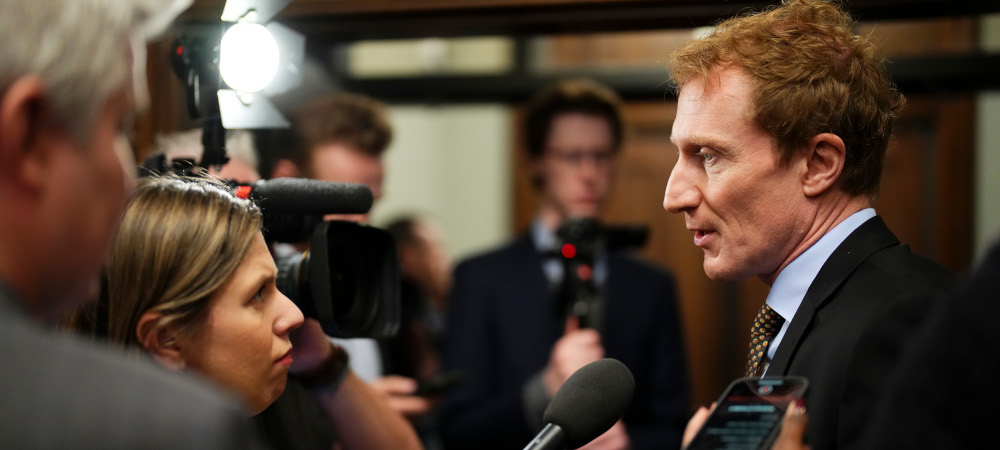The term “land back” isn’t just something you hear from activists yelling at rallies anymore. It’s now coming from the top tiers of government.
When Liberal MP Marc Miller first took office as the Minister of Crown-Indigenous Relations and Northern Affairs in October 2021, he didn’t waste any time making a splash. At his very first press conference, he announced rather casually that “The relationship has been broken because of land theft and it’s time to give land back.”
The statement was sweeping and bold—and understandably intimidating and confusing to many. For years now, Canadians have heard activists calling for the return of vast swaths of territory to Indigenous Peoples—what they consider as payback for land stolen by the Europeans. It undoubtedly had some worrying if they’d soon have to hand over their property.
Miller’s comments were something you would expect to see scribbled as a slogan in a back alley in downtown Toronto, not something asserted by a federal cabinet minister. And yet there he was standing at his first press conference during the first moments of his new assignment and saying it out loud. Did he really mean what he was saying? Was he trying to appease the activist class? What exactly was he getting at?

I heard Minister Miller’s message firsthand when I shared a stage with him last year at a major policy conference. He began his remarks with that same “land back” message. He talked a big game, but the details were fuzzy. Miller described how the current federal policy for returning land, what’s called the “Additions to Reserve” (ATR), was too slow and broken. He then suggested that “land back” actually should mean more than just ATR, that it should involve addressing outstanding treaty grievances and include compensation when returning land wasn’t possible.
But this was nothing new, I thought. It just hadn’t been called “land back” before. It made me wonder if this was a real plan to fix past wrongs, or just another case of politicians re-packaging failed Indigenous policies in shiny new wrapping paper.
While the term “land back” has become an emotionally charged slogan, it actually isn’t a groundbreaking concept. Canadian governments have been actively working to settle land disputes and restore governance and territories to First Nations for more than 50 years now. This work hasn’t been served with sizzling taglines, but it has been measured and effective.
Additions to Reserve
ATR policy was formally introduced in 1972 to help address various Indigenous legal issues like forced historical community re-locations, government economic development restrictions, and the settlement of land claims. Today, it enables the federal government to expand the boundaries of existing First Nations territory in three ways: by adding lands directly adjacent to the current legal boundaries of an existing reserve; by adding parcels of land that are not directly next to existing First Nation but are located elsewhere; and/or, by adding lands to a First Nation to compensate for reserve lands that were taken away.
Since 2015, more than 440 ATRs have been completed, with over 265,000 acres of land having been added to reserves. This past fiscal year alone, 39 ATRs were completed, and many more remain in the queue.
While it is a recognized approach for land repatriation, ATR is a lengthy process, entangled in bureaucracy and delays. However, it remains one of the few existing policies available to address land grievances. In March 2023, the federal government issued a call for proposals to redesign ATR policy, streamline procedures, and accelerate the return of lands.
Despite its challenges, the benefits of the ATR Policy significantly outweigh its limitations. While not all communities have experienced economic growth from territorial additions, the expansion of reserve lands remains a crucial mechanism for fostering opportunities for economic development, community growth, and advancing self-determination.
In 1975, the federal government finalized the James Bay and Northern Quebec Agreement—a pioneering treaty between the Cree Nation of Eeyou Istchee, Inuit of Nunavik, the government of Canada, the government of Quebec, and Hydro-Quebec. The agreement greenlit hydroelectric projects in exchange for resolving Indigenous land claims in the western and northern parts of Quebec.
It is an understatement to say that this agreement had a tremendous impact on the economic, social, and environmental well-being of the Cree and Inuit peoples. It also set an important precedent for future treaty-making in Canada.
For more than 50 years, Canada has also negotiated more than 20 modern treaties along with resource-sharing and land agreements. These treaties and agreements have brought a level of certainty that benefits First Nations, governments, and industries, leading to more equitable resource development deals.
Significant strides have also been made through specific claims policy, which deals with grievances over unfulfilled treaties or mismanaged lands and assets. In 2007, Prime Minister Stephen Harper was instrumental in establishing the Specific Claims Tribunal under the “Justice at Last” policy, with a vision to cut through the red tape that previously bogged down the resolution process. Prior to the creation of the tribunal, resolving these claims was a slow and frustrating ordeal that created a hefty backlog and frustration among First Nations.
Since 1973, Canada has resolved 665 specific claims, shelling out close to $12.5 billion in compensation, with 270 of those claims settled since 2015, totaling nearly $9.5 billion.

Resource profit sharing
Although it has yet to be implemented, it’s worth mentioning the recent endorsement from Pierre Poilievre of the promising First Nations Resource Charge (FNRC). This charge could put a fresh spin on the “land back” narrative through a practical approach. Again, this isn’t just another policy pulled out of thin air; it is a fiscal policy initiative developed by the First Nations Tax Commission, led by Chief Commissioner C.T. (Manny) Jules. It’s designed to allow First Nations to exercise fiscal jurisdiction over resource projects on their lands by levying a charge on natural resources extracted in their territories. This would permit First Nations to collect 50 percent of the federal taxes directly from industry projects on their lands, with industry getting a tax credit in exchange.
Currently, under the Indian Act, the federal government collects taxes from resource projects and then sends the money back to First Nations from Ottawa. First Nations are then expected to engage in lengthy bureaucratic processes and complex negotiations to get the money back into their communities.
While there are questions as to where this positions First Nations and industry on their path to building equity and other business partnerships, this policy represents a practical method that aims to ensure First Nations receive a fair share of the profits from natural resources extracted from their traditional lands. This approach is about more than just returning land—it’s about sharing the wealth generated from that land, which can lead to substantial improvements in the infrastructure, education, and health care of First Nations communities.
It’s an example of how “land back” can evolve from a nebulous concept into a concrete policy that delivers actual l results. It could provide economic benefits, aligning with the broader Indigenous goals of sustained community development. This move by Poilievre is a promising shift towards acknowledging the importance of not just recognizing historical land rights but also embracing the economic potential that comes with those rights.
While territorial repatriation is an important part of advancing economic reconciliation, its implementation needs to be approached judiciously to avoid creating turmoil. A case in point is the British Columbia government’s recent legislation to recognize Haida title over the entirety of Haida Gwaii. This decision, while aimed at rectifying historical wrongs, risks creating a legal and social vacuum for current property owners on the islands. If not managed carefully, it could also incite backlash among Canadians, potentially undermining the broader goals of reconciliation and setting back future efforts at land repatriation.
In 2024, it’s clear that the “land back” slogan, while catchy, is more often tossed around to stir emotions than used as the basis for crafting real solutions. It’s a phrase that has been seized by some to generate fear—fear of losing cottages, fear of losing homes, fear of losing access to Canada’s lakes and rivers.
But in reality, those who are shouting “land back” the loudest are often the ones least involved in the actual work of making meaningful changes. They’re not coming up with new solutions that will deliver real results. They’re more concerned about the spectacle than the substance.
As we move forward, let’s focus on these substantive changes—because it’s not the noise that makes a difference, but the steady, determined work of building a prosperous future together.
Recommended for You

Ottawa is letting Canada’s global cannabis advantage erode

Canada should have followed Australia’s lead in rejecting a national bill of rights

Canada’s health-care status quo is ‘nonsensical’: What’s behind Alberta’s reported health-care reforms?

Can David Eby be brought onboard an oil pipeline? Two former NDP staffers weigh in




